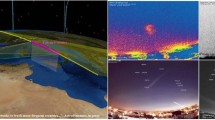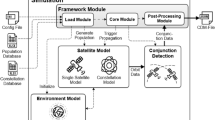Abstract
Low-Earth-Orbit (LEO) region congestion is becoming one of the big issues of the modern space era. To avoid the Kessler syndrome, now more than ever it is needed to improve awareness about space traffic, and upgrade the entire monitoring process. Extensive literature is available covering the topics of orbital conjunction filtering techniques and computation of the Minimum Orbital Intersection Distance (MOID). The present paper investigates Funding and/or Conflicts of interests/Conflict of interest. An alternative filtering method exploits the near-circularity of certain orbits (a condition often verified in LEO), to improve conjunction analysis performance. Elliptical orbits are reshaped through an auxiliary deferent model, inspired by C. Ptolemy’s orbital theory, replacing the real motion along conjunction analysis. To recover satellites’ averaged mean orbital elements, CelesTrack LEO catalogue was considered and propagated. Based on averaged parameters, off-centric circular orbits are considered instead of elliptical ones. The resulting deferents (off-centric circles) are not far from osculating orbits due to LEOs low eccentricities, becoming the basis for the conjunction analysis algorithm. The algorithm is conceived as a sequence of pre-filters and a final MOID computation. Performances are inspected through an all-vs-all analysis, taking as reference a combination of Hoots’ and Gronchi’s algorithms. This method achieves good performance as compared with these traditional benchmarks. Adopting this approach could reduce the time needed for a preliminary conjunction inspection during the first phases of the Collision Avoidance (CA) process, especially in LEO, where pre-filtering aims to reduce the number of orbit couples where precise MOID computation is needed.












Similar content being viewed by others
Data availability
The dataset considered for the present analyses is available from the corresponding author on reasonable request.
Notes
Claudius Ptolemy (latin: Claudius Ptolemaeus) (c.100–c.170 AD) was a mathematician, astronomer, geographer, and astrologer, lived in Egypt at the time of the Roman empire.
Subscript 1 and 2 identify the two deferents through all the tests: 1 is the one with bigger a as defined in Test-1.
Since the perfectly co-planar case is nearly impossible in real orbits.
True Equator Mean Equinox, the reference frame of TLEs used in SGP4.
References
Share My Space : Share My space SAS bullettin (2022)
Sirtarski, G.: Approaches of the parabolic comets to the outer planets. ACTA Astron. 18(2) (1968)
Hoots, F., Roehrich, R.: Models for propagation of norad element sets. Defense Documentation Center (Alexandria) (1988)
Kholshevnikov, K.: Close encounters. Celest. Mech. Dyn. Astron. 91, 278 (2005)
Gronchi, G.F.: An algebraic method to compute the critical points of the distance function between two keplerian orbits. Celest. Mech. Dyn. Astron. 93, 295–329 (2005)
Bonanno, C.: An analytical approximation for the MOID and its consequences. Astron. Astrophys. 306, 411 (2000)
Lidtke, A., Gondelach, D., Armellin, R.: Optimising filtering of two-line element sets to increase re-entry prediction accuracy for GTO objects. Adv. Space Res. 63, 1289–1371 (2019)
Knezevic, Z., Milani, A.: Synthetic proper elements for outer main asteroid belt. Astron. Observ. 78, 17 (2001)
Rozek, A., Breiter, S., Jopek, T.: Orbital similarity functions application to asteroid pairs. Mon. Not. Roy. Astron. Soc. 412 (2010)
U., H., Stivenson, E., Rodriguez, V.: Artificial intelligence for all vs. all conjunction analysis. In: 8th European Conference on Space Debris (2021)
Hoots, F., Crawford, L., Roehrich, R.L.: An analytic method to determine future close approach between satellites. Celest. Mech. 33, 143–158 (1984)
Vallado, D., Cefola, P.: Two-line element sets—practice and use. In: International Astronautical Congress (2012)
NORAD, U.S.F.: Spacetrack. https://www.space-track.org. Last access on: 10 Jan 2023
Kelso, T.: Frequently asked questions: two-line element set format, 1st edition. CELESTRACK website, 2004. (See: https://celestrak.com/columns/v04n05/). Last access on: 10 Jan 2023
Forsythe, M.A.M., G., E., Moler, C.B.: Prentice-hall series in automatic computation. Comput. Methods Math. Comput. 78(17) (1977)
Brent, R.P.: Algorithms for Minimization Without Derivatives. Courier Corporation (2013)
Toronto-University. Hypernova (2007). https://github.com/utat-ss/hypernova
Mahooti, M.: High precision orbit propagator. MATLAB Central File Exchange (2021). https://www.mathworks.com/matlabcentral/fileexchange/55167-high-precision-orbit-propagator
Servidia, P., Espana, M.: Fast and reliable computation of mean orbital elements for autonomous orbit control. Unidad de Formacion SUperior (2019)
Kaula, W.: Theory of Satellites Geodesy, 1st edn. Blaisdell Publishing Co., Waltham (1966)
Ustinov, B.: Motion of satellites along low-eccentricity orbits in a non-central terrestrial gravitational field. Cosmic Res. 5 (1967)
Lyddane, R.: Small eccentricities or inclinations in the Brouwer theory of the artificial satellite. Astron. J. 68(8), 555–558 (1963)
NASA Gmat. https://sourceforge.net/projects/gmat/. Last access on: 10 Jan 2023
Muciaccia, A.: Fragmentation in low earth orbit: event detection and parent body identification. Master thesis, Politecnico di Milano. Faculty of Industrial and Information Engineering, DAER, Master in Space Engineering. Supervisor: Camilla Colombo, Co-Supervisor: Matteo Romano (2019)
Acknowledgements
I want to thank my colleague Paolo Madonia (AIKO) for the support and review of the paper, together with Alessandro Benetton and Davide Vittori (AIKO) who have trusted me in carrying on this research internally.
Author information
Authors and Affiliations
Corresponding author
Ethics declarations
Conflict of interest
The authors have no conflicts of interest to declare that are relevant to the content of this article.
Additional information
Publisher's Note
Springer Nature remains neutral with regard to jurisdictional claims in published maps and institutional affiliations.
Appendices
Appendix A: Test-4 Description
Test-4 setup is better described here.
The following steps allow computing the two crossing points required for Test-4, between the Def-2 and Def-1’s plane.
-
1.
Since Def-2 has been translated in perifocal RF of Def-1, the two points we are looking for belong exactly to the nodal line of Def-2. Moreover \(\Omega _{2}\) is simply the angle from the perigee of Def-1 up to the line of crossing between the planes of orbits. Crossing points are represented in Fig. 8 (down): L and M. Where C is the centre of Def-1.
-
2.
Exploiting previous deductions, two useful triangles could be identified (Fig. 8) on the plane of Def-1: the first one for the point M (\(\hat{\text {Earth-C-M}}\)), and the second for point L (\(\hat{\text {Earth-C-L}}\)). What is needed to set up Test-4 are distances d1 and d2 (represented in Fig. 8), from the centre of Def-1. Once obtained, it will be straightforward to compare these distances with \(R_{1}\), to verify conjunctions at these two locations.
-
3.
In order to obtain d1 and d2, the two previous triangles are solved. Since it is already known the common side \(c_{1}\) (the ellipse parameter of Def-1), at least another side and one angle are needed. Angles between \(c_{1}\) and the two sides \(r_{2_right}\) and \(r_{2_left}\) (distances of L and M from Earth) could be easily computed with \(\Omega \) of Def-2, assuming point (1).
$$\begin{aligned} \begin{aligned}&\hat{{\text {(C-Earth-M)}}}=180^\circ \, -\, \Omega _{2}\\&\hat{{\text {(C-Earth-L)}}}=\Omega _{2}\\ \end{aligned} \end{aligned}$$(4) -
4.
Distances from Earth of points L and M are computed instead considering the geometrical definition of \(\omega \) for Def-2. The procedure is the one represented in Fig. 8b. In this representation Def-1 is the green one, while Def-2 is the red one; L and M are the two big white points. The two distances are computed by recovering eccentric anomalies from true anomalies (the one represented in Fig. 8).
-
5.
Through a well-known theorem, knowing two sides of a triangle and the angle between them the geometry can be solved. In one step, more d1 and d2 are computed.
Once distances d1 and d2 are computed, the aim of this test is to verify if these two points come closer than D to Def-1. This could be verified through the following inequalities:
In case inequalities are both verified, any conjunction is possible at these two points. From the sign of the two differences, we can understand if L and M stay inside or outside Def-1.
Appendix B: Test-5 Description
In this appendix, a more in-depth description of Test-5 is provided.
Since Def-1 lays completely on the horizontal x–y plane of the main RF (due to the rotation performed, in its perifocal RF), the relative distance between deferents can be computed as the sum of the squares between distance from \(C_{1}\) (planar distance) and elevation (out-of-plane distance) from the Def-1 plane, for all points on Def-2. Once the minimum distance is found, it is possible to state if any conjunction will happen or not: if the minimum distance is bigger than D no conjunctions are possible, otherwise at least one is present. The relative distance between deferents is reshaped as a function of the eccentric anomaly E of Def-2 (\(E_{2}\)): this is called F, the function to be minimized. This is defined here:
where \(\vec {P}\) is the position vector of a generic point on Def-2 and \(z_{P}\) is its elevation from horizontal plane (Def-1’s plane). And \(\vec {C_{1}}\) is the position vector of the Def-1 centre. The F function is simply the planar distance from Def-1 together with the vertical distance from the plane of Def-1. Adding the two contributions, the resulting distance constitutes the relative distance between deferents.
The passages to obtain F are reported in the following equation:
\(\bar{\bar{Q_{xX}}}\) is the matrix providing transformation from perifocal to equatorial RF with angles of Def-2 relative to Def-1, this matrix is not a function of E. \(\vec {P}_{\text {perifocal1}}\) is the position vector on Def-2 in perifocal frame of Def-1 at the anomaly selected. The function F provides the relative distance between the two deferents. Once minimised this function, it is sufficient to compare its minimum with the threshold D and verify if at least one conjunction is present or not.
This function is minimised through the algorithm described before. The characteristics of this function are the following:
-
single variable function;
-
non-linear function;
-
F presents probably more than one local minima.
Along the conjunction analysis, in Test-5 both in-plane and out-of-plane thresholds are involved. The minimum found is first checked for the out-of-plane distance and in case it is smaller, it is checked for the in-plane too.
Rights and permissions
Springer Nature or its licensor (e.g. a society or other partner) holds exclusive rights to this article under a publishing agreement with the author(s) or other rightsholder(s); author self-archiving of the accepted manuscript version of this article is solely governed by the terms of such publishing agreement and applicable law.
About this article
Cite this article
Pietro, D.M. A Ptolemaic Approach Improving the Conjunction Analysis Pipeline for Leo. Aerotec. Missili Spaz. 102, 309–321 (2023). https://doi.org/10.1007/s42496-023-00164-7
Received:
Revised:
Accepted:
Published:
Issue Date:
DOI: https://doi.org/10.1007/s42496-023-00164-7




